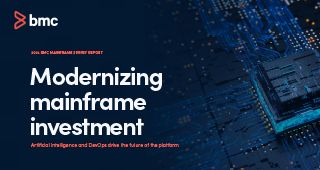In the rapidly evolving digital landscape, CIOs face a pivotal imperative to migrate mainframe data to the hybrid cloud for data management. Delay is no longer an option. In this blog, I’ll present seven compelling reasons why this transformation must happen now, not later. From cost optimization and heightened security to harnessing artificial intelligence (AI) and analytics, each driver emphasizes the urgency for CIOs and IT leaders to embrace the hybrid cloud for mainframe data protection. It’s not just a technology shift; it will also strategically propel organizations into a data-driven future, ensuring competitiveness, efficiency, and resilience in today’s dynamic business environment.
1. Cost optimization
Cost optimization is a compelling driver due to the expenses associated with traditional tape-based infrastructures and virtual tape libraries (VTLs). Maintaining these legacy systems demands significant capital for hardware, maintenance, and storage space. By migrating to the hybrid cloud, CIOs can slash these costs, replace upfront capital investments, minimize operational expenditures, and pay only for the resources they need. This strategic shift also liberates organizations from the constraints of costly and complex tape-based systems, providing a more budget-friendly and agile solution for mainframe data management.
2. Reduced complexity
Mainframes and legacy storage systems can create complex and siloed data environments that require significant time and resource commitments to manage. By transitioning to hybrid cloud mainframe data management, CIOs can overcome the intricate challenges posed by tape-based infrastructures and VTLs to streamline data operations and administration, centralize management, and improve accessibility. This transformative shift alleviates the intricacies inherent in tape-based systems, significantly reducing administrative burden and enhancing overall operational efficiency. It’s a strategic move that empowers organizations to optimize mainframe data management while simplifying their IT landscapes.
3. Enhanced security compliance
Cybersecurity threats, including ransomware attacks, are growing in sophistication and frequency, necessitating a fortified security posture. Hybrid cloud mainframe data management provides that posture by ensuring that data is more secure and easier to protect and offering robust defense mechanisms that include encryption, multi-factor authentication, and continuous monitoring. This strategic transition bolsters data protection shields against cyberthreats, and ensures unwavering compliance with stringent regulations like the European Union’s Digital Operational Resilience Act (DORA), US regulations such as Sheltered Harbor and those of the Securities and Exchange Commission (SEC), and the Hong Kong banking system standard, STDB, all of which help mitigate legal risks. .
4. Cyber resilience
In this era of increasing cyberthreats, organizations must prioritize data resilience. Hybrid cloud solutions often include robust disaster recovery capabilities that ensure that mainframe data can be quickly recovered in the event of cyberattack or other disaster, minimizing downtime and data loss. This enhanced resilience fortifies the organization’s ability to withstand unforeseen challenges and provides a crucial safety net for data protection and business continuity.
5. Harnessing AI and analytics
The hybrid cloud isn’t just about data storage; it’s a conduit to a smarter, more agile, and analytics-driven future—and a gateway to advanced AI and machine learning (ML) technologies that CIOs can leverage to decode intricate data patterns, predict trends, and derive actionable insights from mainframe data. This empowers organizations to make data-driven decisions, drive innovation, and gain a competitive edge in today’s data-centric landscape.
6. Addressing workforce challenges
The expertise required to manage tape-based and VTL systems is dwindling, with experienced professionals retiring amid a shortage of new talent to replace them. Migrating to the hybrid cloud alleviates the risk of losing critical mainframe skills while ensuring efficient, continuous data management, regardless of skill sets, with tools newer IT professionals are familiar with and comfortable using. This strategic shift assures CIOs that their mainframe data is in capable hands, both now and in the future.
7. Scalability and flexibility
Traditional mainframe environments often struggle to adapt to changing business demands. Hybrid cloud solutions offer unparalleled scalability, allowing CIOs to effortlessly adjust and allocate resources to meet evolving organizational needs and fluctuating data requirements. This agility ensures that mainframe data can grow with the business, without the constraints of legacy systems, offering adaptability that is essential for a modern IT ecosystem.
Putting it all together: hybrid cloud for gaining a competitive edge
There is much to gain from hybrid cloud data management—especially if you are planning for long-term mainframe investment. In today’s data-driven business landscape, the ability to swiftly access, analyze, and act upon data is a strategic imperative. The hybrid cloud facilitates this by leveraging AI/ML tools to transform data from a passive asset into a dynamic resource that gives organizations a formidable competitive edge. It also provides an agile platform where mainframe data is readily available for real-time processing, analysis, and informed decision-making.
Those data-driven insights then allow organizations to uncover hidden patterns, respond rapidly to market shifts, identify emerging trends, optimize operations, improve customer experiences and innovation, and unlock opportunities that drive growth and competitiveness. Migrating mainframe data to the hybrid cloud also allows organizations to enact robust security measures and fortify their defenses against cyberattacks by harnessing the transformative potential of AI and analytics. Cloud-based mainframe data management is not merely about data management; it’s also about embracing a future where data is the driving force of success. The time to act is now.
Learn more about hybrid cloud mainframe data management, and hear about one organization’s experience modernizing with hybrid cloud solutions, in this on-demand webinar.







